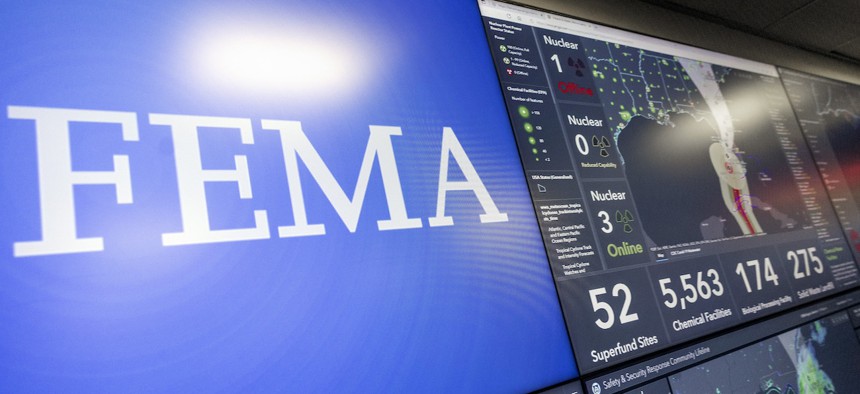
Inside the National Response Coordination Center at FEMA headquarters, on Sept. 28, 2022. The agency is looking to grow its workforce by the equivalent of nearly 1,500 full-time employees in fiscal 2024. Kevin Dietsch/Getty Images
FEMA Is Losing Employees at an Alarming Rate
Burnout is leading to attrition as disasters spike, but watchdog also blames agency for poor workforce management.
The Federal Emergency Management Agency has shed staff at an alarming rate in the wake of the COVID-19 pandemic and an increasing number of disasters, with a watchdog warning in a recent report it has struggled to rebuild its disaster response workforce.
FEMA is 35% short of its staffing needs according to its own statistical modeling, the Government Accountability Office said, leaving it more than 6,000 employees shy of what it requires to confront modern demands. Agency officials blamed increasing burnout and attrition for the shortfalls, though GAO cited the agency for a lack of metrics to improve its hiring processes.
“FEMA currently faces an all-time high in disasters and an unparalleled demand on its workforce,” GAO said, adding the agency will struggle to overcome that challenge without better hiring targets and clearer ways to measure success. The auditors noted the shortages were exacerbated by “the year-round pace caused by the COVID-19 pandemic and increasing number of disasters.”
FEMA’s disaster response workforce has dipped by more than 20% since 2020. Its cadre of public assistance staff went from 100% capacity before the pandemic to just 55% in the years that followed the outbreak, in part due to attrition and in part because the need grew by 130%.
FEMA is looking to grow its workforce by the equivalent of nearly 1,500 full-time employees in fiscal 2024—a figure that includes both its regular, permanent staff and its corps of reservists. Combined with the 1,200 it hopes to add in the current fiscal year, FEMA is aiming for a 20% surge in its staffing levels from the end of September.
The agency reports its “time to hire” to the Homeland Security Department every month, though it does not have a consistent method for doing so. It uses differing starting points and occasionally leaves out entire swaths of new employees. The inconsistency leaves the agency unable to “identify pain points or bottlenecking in the hiring process, and adjust as needed,” GAO said.
FEMA agreed to improve its time-to-hire data, which GAO said could “improve FEMA management’s ability to oversee and make decisions on the workforce planning and the implementation of preparedness actions vis-à-vis future potential emergencies overall.”
The agency has instituted various hiring programs, created bulk hiring events and boosted its use of contractors to fill staffing gaps, GAO said, but it has failed to monitor any of those efforts to measure their effectiveness. FEMA has set overall staffing goals for its disaster response workforce, but not for each of the 23 specific groups contained therein. The agency agreed to better evaluate its hiring efforts and to improve its performance metrics.
“By developing and documenting plans and performance measures to meet staffing targets, FEMA could better ensure it has the capacity to respond to current and emergent threats,” GAO said.
Reps. Bennie Thompson, D-Miss., and Troy Carter, D-La., two of the top Democrats on the House Homeland Security Committee who requested GAO's analysis, said Congress must assist FEMA in building its capacity.
"When disasters strike our communities, we know FEMA needs a properly staffed disaster workforce to do its job effectively and efficiently," the lawmakers said. "While recent events, such as the COVID-19 pandemic, are partly to blame for staffing shortages, it is clear from this report there is much more that FEMA can do to expand its workforce and properly track progress."
As FEMA looks to boost its workforce to carry out its new and added responsibilities, it will have a tool that will make its work more attractive to prospective applicants. President Biden last year signed into law the Civilian Reservist Emergency Workforce (CREW) Act to help it address critical staffing shortages and a recent wave of departures. The law ensures that FEMA reservists, who are only paid by the agency while deployed to a disaster, receive job protections even if they are unable to give notice before deploying to a disaster response. They previously lacked those protections, which lawmakers, agency leadership and the reservists themselves said were decimating recruiting and retention efforts.
In the 1960s, the United States declared an average of 18 major disasters per year. FEMA responded to 104 such disasters in 2020 and 58 in 2021. FEMA’s cadre of reservists have been stretched thin in recent years, as they deployed to not just hurricane and wildfire response but also pandemic, border and Afghan evacuee obligations. Agency employees previously sounded the alarm on their lack of down time between deployments, despite efforts in recent years to bring employees home from pandemic-related assignments to allow them to rest before hurricane season.
NEXT STORY: What Do We Know About Long COVID?







